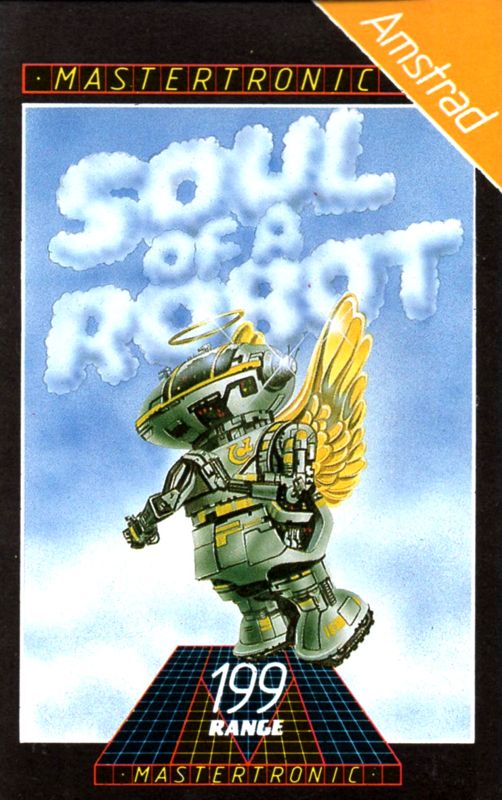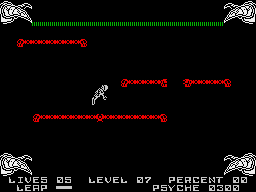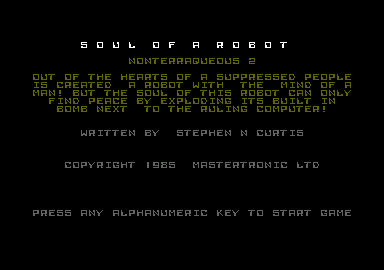Retro Replay Review
Gameplay
Soul of a Robot challenges players with a relentless series of 256 platform-based screens, each meticulously designed to test your reflexes and strategy. From the first few steps, you must carefully gauge the five distinct levels of jump intensity, ensuring that each leap is perfectly timed to clear hazards or reach distant platforms. Learning which jump intensity to use becomes second nature over time, but the margin for error remains razor-thin, keeping tension at an all-time high.
The game’s structure revolves around three sprawling maze-like sections, each one more demanding than the last. To progress, you must locate and activate teleports that whisk your robotic protagonist closer to the heart of the evil super-computer. These teleports also serve as checkpoints of sorts, offering brief respites in an otherwise punishing environment. However, any careless misstep within these labyrinthine zones can send you plummeting back to the start, reinforcing the game’s unforgiving nature.
While each screen introduces new obstacles—spinning blades, energy barriers, and shifting floors—the core challenge remains consistent: choose the right jump intensity, execute with precision, and adapt to unpredictable enemy patterns. This rhythm of trial and error underpins the entire experience, delivering a satisfying loop of near-misses and triumphant clearances. For players who relish exacting platformers, Soul of a Robot offers a deeply rewarding test of skill.
Graphics
Though Soul of a Robot hails from an earlier era of game design, its pixel art aesthetic holds a timeless charm. Each screen is populated with crisp, contrasting colors that clearly delineate safe platforms from deadly traps. The minimalist backgrounds ensure that your focus stays on the action, while subtle animations—like flickering control panels and pulsating energy fields—enrich the atmosphere without overwhelming the eyes.
Character sprites are compact yet expressive, conveying the mechanical nature of your tortured robot hero through angular limbs and glowing ocular sensors. Enemy designs vary from simple drones to more elaborate security bots, each animated with just enough frames to feel alive. This economy of movement lends a certain clarity to fast-paced sequences, preventing visual clutter even when multiple hazards converge.
One of the most notable graphical achievements is the seamless transition between the three maze sections. Though each section shares the same overall art style, distinct color palettes and environmental details help differentiate them. The first section has muted greens and greys, evoking industrial corridors; the second shifts to ominous reds and blacks; and the final approach to the super-computer features pulsating blue circuits that underscore your mission’s urgency.
Story
At its heart, Soul of a Robot weaves a tragic narrative. On the planet Nonterraqueous, a benevolent society has fallen under the thrall of a malfunctioning evil computer that brings ruin to its people. In a desperate bid for salvation, scientists craft a self-aware robot fueled by tortured emotions—designed to find fulfillment only in the act of self-destruction. It’s a haunting premise: a hero who must willingly sacrifice itself to end a far greater evil.
The sparse in-game lore is conveyed through brief text snippets between sections, hinting at the robot’s growing awareness and the weight of its destiny. Each teleport activation seems to stir its internal monologue, revealing subtle shifts in its programming—hints of regret, longing, and the inexorable pull toward oblivion. This minimalistic approach to storytelling encourages players to fill in the emotional gaps themselves, forging a deeper connection to the robot’s plight.
By the time you reach the super-computer’s lair, the narrative stakes feel intensely personal. Your repeated failures and subsequent retries echo the robot’s own internal struggle with purpose and mortality. When the final leap toward self-detonation arrives, the payoff transcends mere gameplay; it becomes a poignant culmination of every jump, every narrow escape, and every fleeting moment of hope.
Overall Experience
Soul of a Robot is a testament to disciplined game design, combining punishing platforming with a somber sci-fi tale. Its steep difficulty curve may deter casual players, but those who embrace its challenge will find a deeply rewarding journey. Mastering the five jump intensities and memorizing screen layouts fosters a sense of growth and accomplishment that few modern platformers can match.
The game’s retro graphics and minimalist storytelling might feel sparse to some, yet these very qualities empower the core gameplay and emotional resonance. Rather than lean on flashy effects or sprawling cutscenes, Soul of a Robot lets you inhabit its world through precise controls and evocative pixel art. The result is a cohesive experience where every hazard cleared and teleport activated fuels both adrenaline and empathy.
For fans of classic platformers and thought-provoking narratives, Soul of a Robot stands out as an unforgettable voyage. Whether you’re driven by the desire to perfect every jump or to see the robot fulfill its ultimate destiny, this game delivers an intense, emotionally charged adventure. While it demands patience and practice, those who persevere will discover a platformer that’s as poetic as it is punishing.
 Retro Replay Retro Replay gaming reviews, news, emulation, geek stuff and more!
Retro Replay Retro Replay gaming reviews, news, emulation, geek stuff and more!









Reviews
There are no reviews yet.